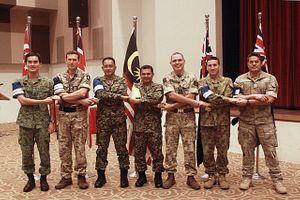This month, the five countries that belong to the Five Power Defense Arrangements (FPDA) – Australia, Malaysia, New Zealand, Singapore, and the United Kingdom – are carrying out another iteration of a military exercise as part of an ongoing cycle of drills. The exercise once again put the spotlight on the FPDA as a regional institution and efforts to further bolster and update it to respond to ongoing security challenges.
As I have noted before in these pages, the FPDA was initially formed in 1971 to help defend Singapore and Malaysia after their independence following the withdrawal of British forces east of Suez and it remains the longest standing multilateral security arrangement in Southeast Asia today. The FPDA includes a set of exercises that have gradually taken shape over time. Among these is Exercise Bersama Lima, which is a joint exercise usually featuring land, air, and naval forces.
On October 1, the latest iteration of Exercise Bersama Lima kicked off with Singapore hosting it this year. The exercise, which lasts until October 19, involves around 3,000 personnel, 14 ships, one submarine, three dive teams, 58 aircraft, five ground-based air defense units, five platoons of ground troops, and various support elements from FPDA nations.
The Singapore defense ministry (MINDEF) characterized the exercise as touching on a number of areas including maritime infrastructure protection, humanitarian assistance and disaster relief, and counterterrorism. This was in line with ongoing efforts over the past few years to ensure that the FPDA is keeping up with contemporary security challenges. The Australian defense ministry’s statement on the exercise noted that it was taking place “in Malaysia, Singapore, and over the South China Sea.”
With respect to activities, according to MINDEF, the full range of FPDA engagements included: on the naval side, gun firing, encounter exercises, helicopter exercises, and anti-air defense exercises; on the aerial side, combined air operations such as air defense, air-to-air refueling missions, and fighter landaways between Singapore and Malaysia at each other’s air bases; and on the land side, professional exchanges and urban operations training. There was also a two-day humanitarian assistance and disaster relief (HADR) planning operation involving humanitarian organizations such as the Singapore Red Cross and Mercy Relief.
In addition to aspects of the exercise itself that will continue to unfold till its official conclusion later this week, there were a number of interactions alongside it as well. This included the customary hosting of senior representatives from the FPDA countries to observe some aspects of the exercises as well.

































